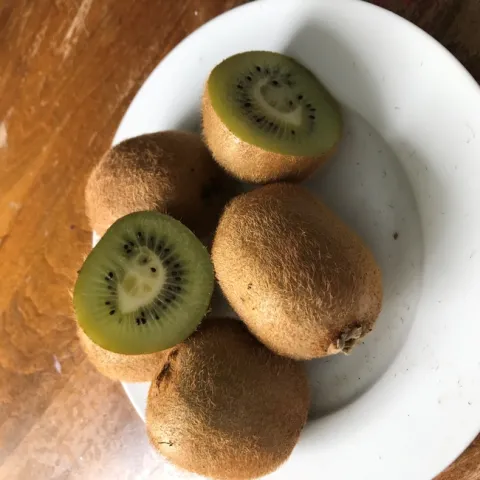
Kiwi
By Andrea Peck UCCE Master Gardener
Kiwifruit (Actinidia deliciosa)
Planting Area: Full Sun, USDA Zones 7-9
Size: Grows 15'-30' tall and 6;-10' wide
Bloom Season: Spring
Fruit Season: Fall
Exposure: Sensitive to frost/freeze.
Pruning Needs: Twice yearly
Water Needs: Medium.
Snapshot:
The kiwifruit is tart, sweet, packed with Vitamin C, and despite all cautionary appearances, the fuzzy exterior is as edible---and delicious---as the interior. Aesthetically, and for maximum fruit gleaning, the vine grows best on a pergola, trellis, or similar supporting structure. Kiwi blooms during the spring and fruits in the fall. During the non-active seasons, the kiwi is a beautiful vine with large, rounded leaves and a somewhat disorderly, yet attractive, mien.
Kiwi grows best in a sunny, but protected location. Pick a spot away from harsh winds, extreme heat, and frost. The kiwi thrives in loose, well-drained soil and prefers moderately moist soil. Though there are varietals that are self-fertilizing, most kiwi vines are dioecious, meaning that the female plant produces fruit only after the flower is pollinated by the male plant. Timing here is key since the male and female plants must be ready for business at the same time. If you are interested in growing and harvesting fruit (and who isn't?) then you will need to get both a male and a female cultivar or one that self-fertilizes.
Though the fun factor of the hairy kiwi cannot be disputed, there are hairless, or smooth-skin varieties such as Anna, Issai, and Ken's Red. Smooth-skin types are generally much smaller; Ken's Red has red, not green, flesh.Each cultivar has different needs so be sure to pick one best suited to your home.
Plant your kiwi after the chance of frost, preferably in the spring. During the first winter, prune the vine to one straight 'trunk.' Each winter thereafter, prune each branch to 8-10 buds. The kiwi does not have a high need for fertilizer---a small dose of compost will keep it in good stead. Kiwi comes in all shapes and sizes, select the appropriate one and you should find success with this easy grower.
We are still here!!!
No in-person workshops for now, but you can view workshops on:
Instagram live at slo_mg or visit our You Tube channel
at “San Luis Obispo County UC Master Gardeners”.
Visit our website; https://ucanr.edu/sites/mgslo/
or email us at anrmgslo@ucanr.edu
Our physical offices are closed, but you can still call or email questions:
San Luis Obispo 805-781-5939
Arroyo Grande 805-473-7190
Templeton 805-434-4105

